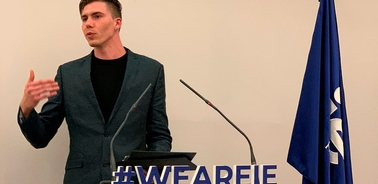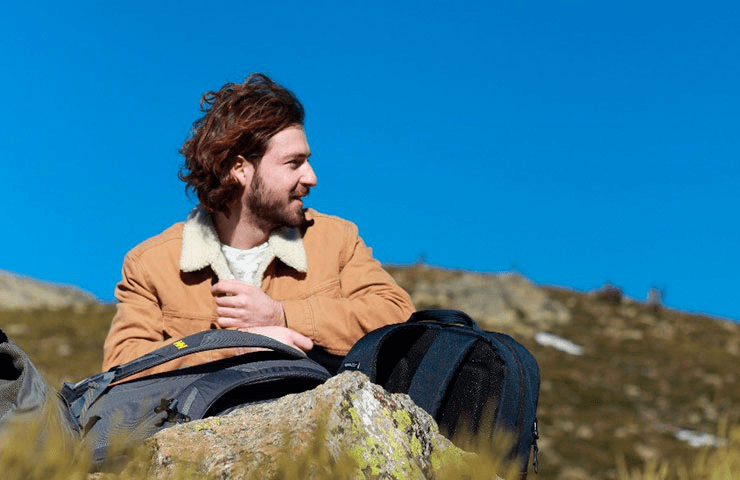- Home
- Using Augmented Reality To Raise Awareness Of The Sustainable Development Goals
Using Augmented Reality to raise awareness of the Sustainable Development Goals

The United Nations Sustainable Development Goals (SDGs) are a shared blueprint for long-term peace and prosperity for everyone on the planet.
Master in International Development alum Maxime Le Lijour and his fellow team members wanted to raise awareness of these critical objectives among young people. Together with colleagues Orphée Sadegh Zadeh and Jean-Baptiste Bove, they participated in the SDG Challenge to show how our actions can make a difference.
Tell us about yourself, Maxime.
I’m Italian-French, from Varese in Italy. I’m a curious person with a passion for reading and writing. I’ve spent my career working in non-profit and multilateral organizations for fundraising, resource mobilization and communications. After completing the Master in International Development, my work has focused on SDG 2: Zero Hunger. I first worked with Action Against Hunger, and then moved to the UN World Food Programme. I’m trying to improve my advocacy and communications skills as well as my ability to mobilize resources in times of crisis. Currently, I work in communications for UNICEF's migrant and refugee programme in Italy.
And the rest of the team?
Orphée is from Paris, and after completing the Master in International Development, she spent over five years in strategic consulting and marketing for the pharmaceutical industry. She’s currently focused on SDG 3, and exploring how to strengthen health systems and health equity at the international NGO, PATH. Jean-Baptiste is from Madrid, and originally began his career in biomedical engineering and product management of AI software. Since the Master in International Development, he’s been working as product owner for a centralized tool used by humanitarian organizations to monitor global crises and coordinate needs assessment.
So tell us about the SDG Challenge Instagram Filter. What inspired you to use Augmented Reality to create an advocacy tool?
Orphée, Jean-Baptiste and I knew that any tool we created had to be aligned with our target population. We wanted to reach young people, so that objective and some “out-of-the-box” thinking made AR seem an obvious choice. Augmented Reality is relatively unexplored compared to some other tools. It’s crazy to think that many multibillion-dollar organizations have never thought about developing a well-made AR filter on Instagram.
We all realised that the communication strategies that are generally employed can be very effective with people who are already in the NGO sector, but not necessarily with outsiders and young people. So we found a fun way to lure people into the world of the SDGs. We wanted to see how far we could go, and we were surprised by the reactions of our audience every time we pitched the idea, as well as the support we got from the IE Community.
Can you describe some of the challenges you encountered and how you overcame them?
We came across a few challenges, including keeping the project alive and transferring its ownership—as we would be leaving the University before its implementation. This is where IE University’s resources and clubs’ support were amazing. They believed in the project and empowered us to execute it.
The University directed us to existing resources, called for action among various clubs, and coordinated the whole thing. Without the IE Community, everything would probably just have stopped at the SDG Challenge. In fact, it’s thanks to Campus Life that we managed to coordinate between all the different actors involved in the creation of the filter. And we need to thank the IE Learning Innovation Lab. They took our ideas and developed them into a concrete filter. We also need to thank the clubs, with whom we designed the content for the challenge. We could never have done this alone and, through the Master in International Development, our professors, our own contacts and the support of the SDG Club, we received valuable insights from a lot of people.
 Jean-Baptiste Bove
Jean-Baptiste BoveWhat are your plans for taking the project forward?
After the launch, we decided to transfer complete ownership of the project to the IE Environmental Sustainability Committee. They will decide whether more will be done with it. There’s great potential to transfer it to other platforms such as TikTok, but, after all, it’s not ours anymore—now it belongs to the IE Community, and we are happy about that. Currently, we are looking at expanding the filter’s reach at other institutions. For instance, the project has been shared with the United Nations SDG Action Campaign, which will help us by posting on social media about it.
What advice would you give to anyone interested in launching an innovative project on sustainability and social impact?
Just do it. Sometimes, we have good ideas that are simply forgotten because they remain just that: ideas. Don’t hesitate to present your project to IE Campus Life. And, while it’s good to think about the details of a project, don’t forget that a fundamental step in innovation is failure. Don’t overthink your ideas, just throw them out there and worry about adjusting the trajectory later on. You will be glad that you did it, even if you fail.